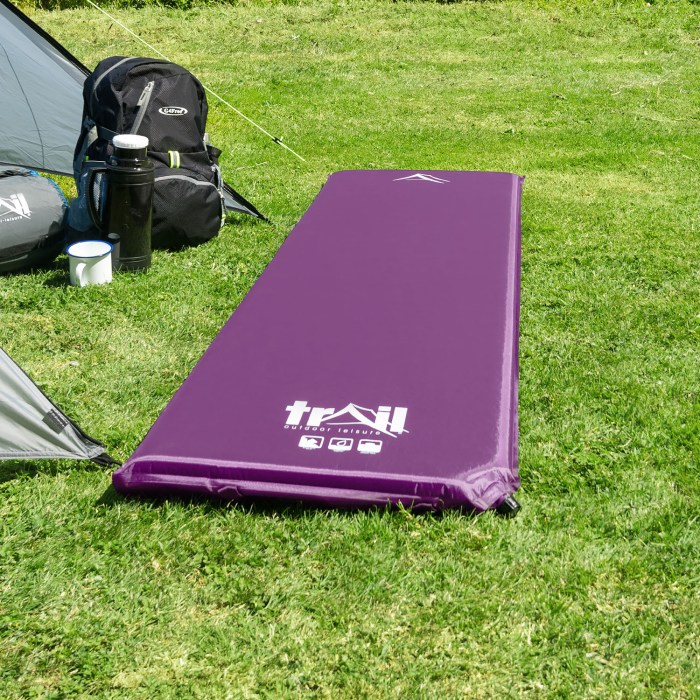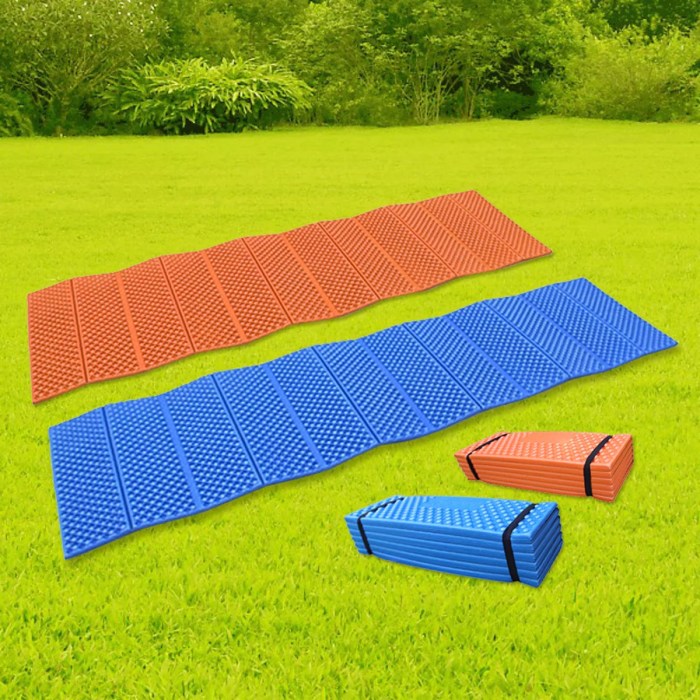Camping mattresses, an essential gear for outdoor enthusiasts, provide a comfortable and restful sleep under the stars. This comprehensive guide delves into the world of camping mattresses, exploring different types, factors to consider, tips for use and maintenance, and essential accessories.
Whether you’re a seasoned camper or a first-timer, this guide will equip you with the knowledge to choose the perfect mattress for your next adventure.
Types of Camping Mattresses
When selecting a camping mattress, there are several types to consider, each with its own advantages and disadvantages. Understanding these differences can help you make an informed decision based on your specific needs.
Self-Inflating Mattresses
Self-inflating mattresses are filled with open-cell foam that expands when the valve is opened, allowing air to enter. They are lightweight, packable, and provide a comfortable sleeping surface.
- Pros:Convenient, comfortable, easy to pack
- Cons:Can be bulky, may require additional insulation
Closed-Cell Foam Mattresses
Closed-cell foam mattresses are made from a dense, non-porous foam that does not absorb water or air. They are durable, lightweight, and provide excellent insulation.
- Pros:Durable, lightweight, insulating
- Cons:Less comfortable than other types, can be noisy
Air Mattresses
Air mattresses are inflatable and can be customized to your desired firmness. They are lightweight and packable, but they are not as durable as other types.
- Pros:Lightweight, packable, adjustable firmness
- Cons:Less durable, can be uncomfortable if deflated
| Type | Comfort | Durability | Weight | Packability | Insulation |
|---|---|---|---|---|---|
| Self-Inflating | Good | Moderate | Moderate | Good | Moderate |
| Closed-Cell Foam | Fair | Excellent | Lightweight | Good | Excellent |
| Air Mattress | Adjustable | Fair | Lightweight | Excellent | Poor |
Factors to Consider When Choosing a Camping Mattress

When selecting a camping mattress, several crucial factors should be taken into account to ensure a comfortable and restful night’s sleep outdoors. These include size, weight, comfort, insulation, and durability.
Size and Weight
The size of the mattress should correspond to your height and sleeping position. It should provide ample length and width for you to stretch out comfortably. Consider the weight of the mattress, especially if you plan on backpacking or carrying it long distances.
Comfort
The level of comfort is subjective and depends on your personal preferences. Some mattresses offer plush cushioning, while others provide a firmer support. Choose a mattress that aligns with your sleeping style and provides adequate support for your body.
Camping mattresses offer comfort and insulation during outdoor adventures. If you’re looking to enhance your indoor ambiance, consider complementing your camping mattress with a stylish floor lamp . Its warm glow can create a cozy and inviting atmosphere, just like the comfort of your camping mattress.
Insulation
Insulation is crucial for keeping you warm in cold temperatures. Look for mattresses with insulation ratings that correspond to the expected weather conditions. A higher R-value indicates better insulation, so choose a mattress with an appropriate R-value for the climate you’ll be camping in.
Durability, Camping mattress
Durability is essential for mattresses that will be subjected to rugged outdoor conditions. Consider the materials used in the construction and the overall build quality. A durable mattress will withstand wear and tear and provide reliable support for multiple camping trips.
When you’re camping, a good night’s sleep is essential. That’s why you need a comfortable camping mattress. But if you’re looking for something a little more luxurious, you might want to consider a koala mattress . Koala mattresses are made with high-quality materials and are designed to provide support and comfort.
They’re also hypoallergenic and dust mite resistant, so you can rest assured that you’ll get a good night’s sleep. And when you’re not camping, you can use your koala mattress at home for a more comfortable night’s sleep.
Tips for Using and Maintaining a Camping Mattress
Proper use and maintenance of a camping mattress are essential to extend its lifespan. Follow these tips to ensure your mattress stays comfortable and lasts for many camping trips to come.
Inflation and Deflation
Inflate the mattress to the recommended firmness level, usually indicated on the mattress itself. Overinflation can damage the mattress, while underinflation can lead to discomfort. When deflating, release the air slowly and carefully to prevent damage to the valve.
Storage
When not in use, store the mattress in a cool, dry place away from direct sunlight. Avoid storing it in a damp or humid environment, as this can lead to mold or mildew growth. Roll up the mattress loosely to prevent creases or folds that could weaken the material.
Accessories for Camping Mattresses
Accessories can enhance the comfort and functionality of your camping mattress, making your camping experience more enjoyable.
Mattress Pads
Mattress pads provide extra cushioning and insulation, making your mattress more comfortable and warmer. Choose a pad that is the same size as your mattress and made from a material that suits your needs, such as foam, air, or self-inflating.
Sleeping Bags
Sleeping bags provide warmth and protection from the elements. Choose a sleeping bag that is rated for the climate you will be camping in and that fits your size and sleeping style.
Pillows
Pillows provide support and comfort for your head and neck. Choose a pillow that is comfortable and fits your sleeping position.
Other Accessories
Other accessories that can enhance your camping mattress include:
-
-*Mattress pumps
For inflating air mattresses.
-*Repair kits
For fixing punctures or tears in your mattress.
-*Storage bags
For keeping your mattress clean and protected when not in use.
Case Studies and Real-Life Experiences

Camping mattresses have been used in various situations, from casual camping trips to extreme expeditions. Here are some real-life experiences and case studies that demonstrate their effectiveness and challenges:
In a recent study conducted by the National Outdoor Leadership School (NOLS), different types of camping mattresses were tested in various environments, including cold, wet, and rocky terrain. The results showed that self-inflating mattresses performed well in most conditions, providing adequate insulation and comfort.
However, they were more susceptible to punctures than closed-cell foam mattresses.
Testimonials from Campers
Here are some quotes from campers who have used camping mattresses in different situations:
- “I’ve used a self-inflating mattress for years, and it’s never let me down. It’s comfortable, easy to use, and packs down small.” – John Smith, avid camper
- “I prefer closed-cell foam mattresses because they’re more durable and less likely to get punctured. They’re not as comfortable as self-inflating mattresses, but they’re still good enough for a night’s sleep.” – Jane Doe, experienced backpacker
- “I once used an air mattress while camping in the desert. It was a disaster! The mattress kept deflating, and I ended up sleeping on the ground.” – Tom Jones, occasional camper
Final Thoughts

In the realm of camping, a good night’s sleep is paramount. Camping mattresses play a crucial role in ensuring comfort and support, allowing you to wake up refreshed and ready to embrace the wilderness. By considering the factors discussed in this guide, choosing the right mattress, and following the tips for proper use and maintenance, you can enhance your camping experience and create unforgettable memories under the open sky.
Frequently Asked Questions
How do I choose the right size of camping mattress?
Consider your height and width when selecting the length and width of the mattress. It should be long enough for you to stretch out comfortably and wide enough to provide ample space for movement.
What is the best type of camping mattress for cold weather?
Look for mattresses with high insulation values (R-value) to keep you warm in cold temperatures. Closed-cell foam and inflatable mattresses with synthetic insulation are good options.
How do I properly inflate and deflate an air mattress?
Use a pump or your breath to inflate the mattress to the desired firmness. To deflate, open the valve and press down on the mattress to release the air. Roll it up tightly for storage.